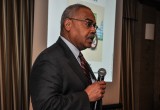Long Island's first grassroots conference on medical diagnostic error and patient safety identified two areas for action: reforming healthcare institutions and making them more accountable, and educating patients to ask the right questions.
Online, March 5, 2014 (Newswire.com) - On Monday this week, a mixed audience of healthcare professionals, patient safety advocates and concerned citizens gathered in Plainview, NY, to discuss the critical issue of errors in medical diagnosis. The seminar, Medical Diagnosis: Help Your Doctor Help You, was prompted by the grim statistic that an estimated 40,000 to 80,000 people die in the US each year as a result of a wrong diagnosis.
According to Ilene Corina, founder and President of PULSE of NY, the grassroots patient safety advocacy group that organized the event, "As patients (supported by our families and friends) we must learn how to communicate better with doctors and other healthcare staff. We need to tell our doctors what's going on with us in a clear, complete, and logical way. This is something we can all learn to do, and PULSE of NY provides training in how to do it. We also need to push our doctors to consider all possible explanations for our symptoms, not just jump to the most common or likely cause.
"On the other side, the medical profession and hospital administrations must become more accountable. Diagnostic practices must be improved, and healthcare institutions and staff must be more willing to take responsibility when something goes wrong."
Speakers underscore the message
Trisha Torrey, About.com's expert on patient empowerment issues and author of several books, told her story: misdiagnosed a decade ago with a rare terminal cancer and slated for chemo, she endured months of anguish and lost the bulk of her life-savings. Only through her own persistent research did she finally convince the doctors that she was in fact healthy.
"Patients," says Torrey, "need to start taking responsibility for things we've never been responsible for before. Nobody taught us how to make a list of questions for the doctor, or how to talk to one. Nobody's taught us where the good information is on the Internet, instead of the stuff just intended to sell us things. We can't just lay blame or wait for the system to be fixed: there are things we can actually do keep ourselves and our loved ones safer."
In 2009, Torrey founded the Alliance of Professional Health Advocates, helping people become privately employed advocates for patients who do not have the strength, knowledge, or resources to guard their safety while under care.
Dr. Jack Rubenstein, who holds senior positions in North Shore-LIJ and its Hofstra School of Medicine, specializes in complex, difficult-to-diagnose cases and likens himself to TV's doctor House, "but with a better personality."
He noted that a diagnosis may change over time, and if you ask two doctors to interpret the same symptoms or data, they may disagree. He outlined the ways in which doctors and patients can partner more effectively. "The patient must provide as much context as possible," he said, "or the outcome of the clinical reasoning process won't be satisfactory."
He cited intuition as a common cause of misdiagnosis. "As doctors gain experience, we increasingly diagnose through a fast-track intuitive system. That's very efficient, but it's fraught with error. So you, the patient, need to be the red flag. You need to say, 'Doctor, I don't understand your logic here. Maybe the fast answer you just gave me doesn't make a lot of sense.' Don't be in a rush, and don't allow the clinician to rush you."
Miscommunication dramatized
The need for effective communication was brought to life through a humorous skit in which Ilene Corina played the role of doctor and actor Alix Stoll played a patient trying, unsuccessfully, to describe her symptoms in the kind of sloppy, exaggerated language that we all use daily. How long have you had these symptoms? Oh, forever! Is there anything you do that makes it worse? Everything makes it worse! Are you taking medication? Yes, the doctor gave me something but I can't remember what it's called.
The message was clear: diagnosis is based on evidence, and we as patients need to be accurate and unambiguous when talking to clinicians.
"We hurt and kill too many people"
The final speaker was Dr. Ronald Wyatt, Medical Director in the Office of the Chief Medical Officer at the patient safety watchdog, The Joint Commission. A self-styled "patient safety extremist," Dr. Wyatt said, "We hurt and kill too many people in healthcare, every day. Five percent of US hospital autopsies show evidence of lethal diagnostic error. Voluntary reporting of incidents by doctors is dismal. I often hear, 'If it weren't for me, that patient would have died sooner.' Hospitals say, we have great physicians here; we did nothing wrong."
"This means that diagnostic error isn't being recognized as a failure of the system. We need to analyze these events, understanding how and why they happened and how we can take corrective actions that will decrease the risk of it happening again. We need 'predictive' analysis that will anticipate the next risk." And he added that medical institutions have a financial motivation: medical errors are very costly.
While stressing that doctors need to see patients as people, not just cases, Dr. Wyatt also addressed the patient's responsibility for his or her own health, citing the story of an older relative of his. Poor, uneducated, uninsured, and diagnosed as diabetic, he improved his diet and activities so much that he was able to go off medication within a year. He succeeded, said Dr. Wyatt, because "he had the knowledge, the skills and the confidence, within himself and his family."
To learn more about the conference, or about PULSE of NY's programs of education and advocacy, please contact Ilene Corina on 579-4711.
Share:

